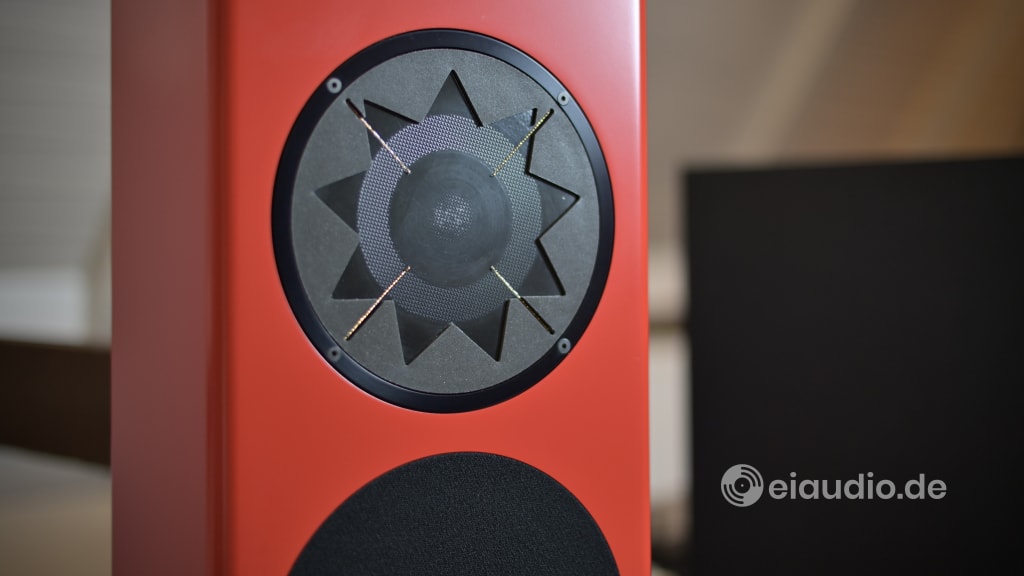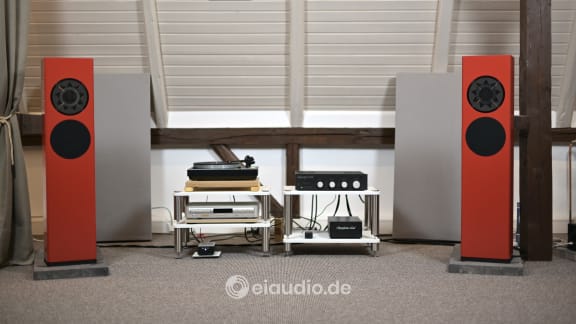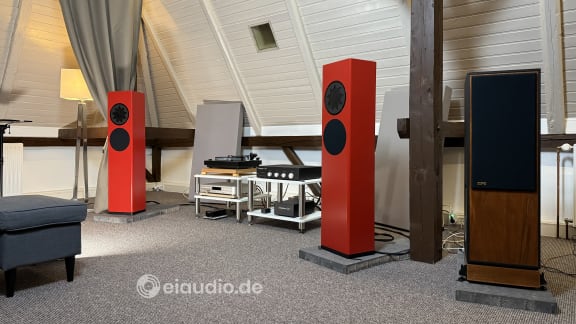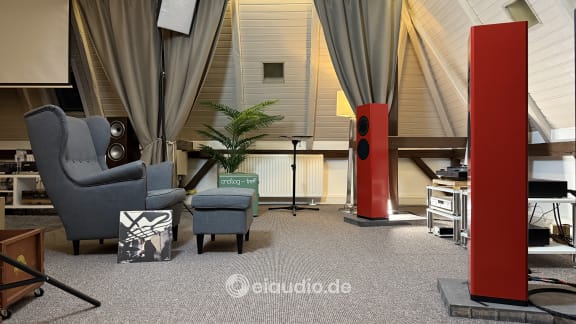Manger Audio p2
Published: 11/02/2025
Manufacturing date: 2023
Author: Karsten Hein
Category: Gear & Review
Tag(s): Loudspeakers
Sure, I know Manger
I was 19 years old, observing a friend of mine solder the last wires of an amplifier project. He wanted to know if I had heard of the Manger (German family name pronounced: 'maŋɐ') Bending Wave Transducer and claimed it was among the best driver principles ever devised. I told him that I had not yet heard of it, and so he went on to explain its revolutionary design to me. Although this conversation took place more than thirty years ago, my fascination with the Manger transducer remained. I was especially interested at the time, as I was constructing my own D.I.Y. loudspeakers, and the difficulties arising from multiple pistonic drivers paired with complex crossovers were quite obvious. The promise of a smoother speaker concept that worked without crossovers in the frequencies critical to the human ear was intriguing to me.
In summer 2022, my favorite audio technician, Winfried Echle, was building a set of speakers of his own and handed me a strange-looking driver as one of the possible high-to-mid frequency choices. “This is a Manger transducer!” I exclaimed happily, eager to communicate the fact that I already had the proper term for it. As it turned out, I was holding the W05 model of the bending wave transducer in my hands. It mostly consisted of machined metal components and strong magnets and was therefore very heavy. Its round front was covered with a dark, slightly textured, and rubbery-looking diaphragm, which was surrounded by a star-shaped matte. For a full-range driver that could reach ultra-high frequencies well above the human hearing, its diameter was quite enormous. And from the looks of it alone, I honestly could not imagine how it would sound.
First Encounters
Winfried ultimately decided to use a different type of full-range driver for his loudspeaker project, and I did not get the chance to listen to a Manger transducer until CEO Daniela Manger released the W06 driver and hosted a demonstration of her P2 loudspeakers at the HiFi-Auditorium shop in the German town of Münster in Westphalia. The event was scheduled for the autumn of 2024, and I managed to secure a ticket for it. Upon arrival, I began my audition by examining the design: The P2 are sleek-looking, column-shaped loudspeakers, approximately 1.15 meters tall, less than 30 centimeters wide, and just over 20 centimeters deep. Their outer finish is smooth to the touch, and the excellent paint job hides a sturdy and quite heavy aluminum cabinet underneath. Unless you have to carry them around, you would never guess from their appearance that each speaker weighs a hefty 33 kg.
Each P2 comes fitted with Manger’s latest Generation W06 transducer, which is accompanied by an agile German-made woofer of the same diameter sitting underneath. The back of the P2 cabinet holds two passive radiators and a large metal terminal with WBT Cu nextgen binding posts for bi-wiring application. The label above the connectors declares the P2 to be an 8-ohm speaker with an RMS rating of 200 watts. It also shows the production date and the serial number, as well as the company's claim “Präzision im Schall” (Precision in Sound). On this day, however, the P2 were positioned along the narrow side of the Auditorium Münster's listening room, standing relatively close to the front wall and at equal distance to the left and right side walls. With the audience chairs positioned rather centrally in the room, my ears were struggling with standing waves and reflections from all sides. Sadly, this was not the ideal environment for testing the audio quality of the system.
To make the most of my trip and still have a chance to get a more accurate impression of the P2 speakers, I asked Ms. Manger for the possibility to listen to them in our studio. She responded positively, saying that potential buyers are given the chance to test her speakers at their homes for a small transport fee of 200.00 euros. (This is true for German customers and at the time of writing this. Prices and conditions may vary or change.) And that is how I ended up taking the Manger P2 loudspeakers home with me for an audition following the Norddeutsche HiFi-Tage 2025 audio fair in Hamburg. Safely wrapped in non-scratch cloth and stored in their original boxes, the speakers were easy to load into our car. Carrying them up the multiple flights of stairs to our studio was another matter, of course.
Setting up the System
I began my explorations by placing each Manger P2 in the same location that my Martin Logan SL3 electrostatic speakers had been in before. This was a tried and tested position, determined by means of calculation and hours of listening. I used a laser gauge to confirm that the driver planes of both types of speakers (the P2 and the SL3) were absolutely identical in relation to the front wall of the room. Our listening space is quite large, roughly 9 x 7 meters, and I applied my usual room resonance calculation to set up an equilateral triangle of 2.5 meters distance between each speaker and towards my listening position. In this setup, the distance from the driver plains to the front wall measured 1.65 meters straight.
As our house was constructed in 1901 and still has the original wooden beams and floors, I place all my speakers on 40 kg concrete slabs. In fact, I first started doing so, when I learnt that simply doubling up the floor boards to 6 cm thickness and then adding a carpet on top was not enough to quiet resonances. The heavy concrete slabs have greatly helped to solve the issue since, but vibrations do play a role in less obvious positions as well. Some of them emanate from the HiFi system itself. To lessen their impact, the equipment driving the speakers is positioned on two separate racks that use steel tubes filled with silica sand. The rack on the right holds the Symphonic Line RG10 Reference HD amplifier with its two large and heavy transformers resonating at 50 Hz; and the rack on the left holds the sensitive optical and mechanical drive units of the Marantz CD player and the Thorens TD 320 turntable. Each of these devices is then further decoupled from vibrations by means of dedicated bases and absorbers.
The cables behind the system do not touch, in order to prevent cross-induction and distortion. Possible differences in ground potential have been harmonized between the devices. HF shielding from the power source is provided via shunt filter, and all power cables use simple ferrite beads to further reduce high frequency noise in the system. The Thorens turntable is fitted with an affordable Audio Technica VM95 cartridge (MM) and micro-linear stylus. Its motor is driven with a special linear power supply made by Audiophonics of France. The speaker cables are single-wired WSS Platin Line LS4 (hand-crafted by Jochen Bareiß in Nürtingen, Germany) and used in combination with the cable bridges that are originally included with the speakers. Given a choice, I would have preferred to test the bi-wiring version of the WSS cables, but they were not available to me at the time. My own bi-wiring alternative, one that was based on two strands of Belden 9497 wires, did not sound as tonally convincing in combination with the powerful Symphonic Line amp. I therefore stayed with the WSS.
The Listening Sessions
Fleetwood Mac (1970s Pop)
In order to ease my way into the listening session with some simple and familiar tunes, I put on Fleetwood Mac’s Pop album “Rumours” on the Thorens turntable and sat down in my usual chair. I listened to all songs on Side A and thereby noticed two things: The soundstage did not pan seamlessly. There was an acoustic left, the phantom centre, and a right, however, there was no connection between them. This surely was the result of the Manger P2 beam angle being slightly narrower than that of my Martin Logan SL3 speakers. I rotated the P2 inward towards the listening position, until their acoustic beams were crossing just behind my head. This successfully closed the stage for me and made the music pan from left to right more seamlessly. I also read reports in which reviewers toed in the P2 so that their beams crossed even in front of the listening position. However, being very sensitive when it comes to realistic sound direction, I did not gain much from the experience when I tried it myself.
The second thing I noticed was some inaccuracy in the sound stage itself, as if there was an extra layer of music which blurred over the first one. This can sometimes happen when reflections from the front wall of the room bounce back towards the listening position, creating time smear and acoustic fog. If this phenomenon had also been present on my Martin Logan speakers, I had not noticed it as much, due to their filling-in dipole characteristic (which entails other challenges, of course). I borrowed two large 120x60 cm absorbers from my adjacent system and stood them up against the wall behind the P2 speakers. Clarity, dynamics, and soundstage were drastically improved. In a normal household, curtains or bookshelves placed behind your speakers should give you a similarly positive effect.
I put on “Rumours” once again and enjoyed how well the changing speeds and intensities of each drum beat were captured by the 1976 recording. The quality of vocals also varied greatly between songs, and the P2 faithfully revealed the strengths and shortcomings of each one. Driven with the capable Symphonic Line Reference HD amplifier, each sound had its own space, dimension, and was clearly discernible in its temporal rise, timbre, and decay. In the title “Don’t Stop”, there was plenty of forward drive, paired with the obviously constrained dynamics of the recording equipment of the time. I felt so close to the recording event itself that I could sense the studio reels turning in Sausalito. The album was a reminder of how colourful even vintage music can be, if we have the ability to untangle it in all its facets.
Helge Lien Trio (2020s Jazz)
Following my impression of the 1970s, I was looking for a more complex, contemporary recording that would reveal multiple layers of music. I picked out the Helge Lien Trio’s Jazz album “Hello Troll”, on which Side A feels like a harmonious battle between piano, bass, and drums. On this special 2008 recording, Helge Lien’s piano extends across both channels with the high keys to the right and the low keys to the left, as is customary in modern studio Jazz recordings. Frode Berg plucks his bass in the right third of the stage, and Knut Aalefjoer beats his drums in the left third. There was a true sense of stage depth and musical order which was superior to any setup I had heard play in this position before. The music came to its full dimension in our studio without carelessly revealing the position of the speakers, and there was a natural flow and rhythm.
Next to the tonal richness of the piano, I enjoyed the taut bass, which extended surprisingly low. The first half of the title “Troozee”, which can easily seem a bit monotonous, became highly entertaining for its faithful bass rendering alone. As the song picked up momentum, the Manger P2 could show their ability to maintain micro-dynamics and transients during complex musical passages. I would say that their ability to keep sonic events separate and discernible is widely unmatched. And this does make sense, as the W06 transducer is a single-point source that is capable of rendering all frequencies from 40,000 Hz down to 150 Hz. And it does not matter at all that it is prematurely cut off at 340 Hz to increase the P2's power handling capacity to 200 watts, because all relevant directional frequencies, as well as their harmonics, originate from a single flat plain which naturally directs its waves outward in concentric circles, similar to the skin of a drum or the basal membrane of the human ear.
2Cellos (Acoustic Song Covers)
When I changed from vinyl over to my trusty Marantz CD-17 CD player, the music remained fluid and tonally rich. Having picked out the 2Cellos album “IN2ITION”, I began with the familiar Police cover “Every Breath You Take” and was surprised to find that the bass lines were actually plucked on a third instrument. Due to the combo’s name I had always assumed that I was listening to exactly this: Two cellos. However, the P2 made it strikingly obvious that there were three instruments at play in the recording. Trained musicians will probably detect this on any system, but to my more technically oriented ears, the additional order provided by the P2 speakers proved to be helpful. The titles “Supermassive Black Hole” and “Clocks” were more insightful and fun on the Manger speakers. I even dared to turn up the volume to 90 dB (a quick measurement on my phone's dB meter) and found that the P2 remained in perfect control of the event, although I could detect a subtle increase in room resonances.
Youth Lagoon (2020s Indie, Electronic Music)
My next music pick was the 2023 album “Heaven is a Junkyard” by Youth Lagoon. On this, the Boise, Idaho-based Trevor Powers put together a bunch of contemplative often melancholic songs featuring soft piano playing, gentle acoustic guitar, and subtle synths. The album creates a warm blanket of sound that is both soothing and fun to listen to. As with many modern recordings, Heaven is a Junkyard is quite compressed and sounds dense throughout. On occasion, substantial bass waves are sending tremors through the room. Power’s delicate and breathy vocals blend vulnerability with a dreamlike, almost ghostly quality, and the P2 keep this vocal quality alive, even as the background choir and heavy instrumentation set in.
Sean Keel (2020s Singer-Songwriter)
“A Dry Scary Blue” is Texan songwriter Sean Keel’s 2022 appearance in the realm of audiophile recordings. Mastered in collaboration with Gabriel Rhodes, its scarcely instrumented songs are soothing and whispering. On the P2, the album sets an acoustically spacious backdrop of piano and guitar with Sean’s vocals seeming ever so fragile and brittle. More than my Martin Logan SL3, the Manger speakers reveal both the conceptual strengths and the acoustic shortcomings of the recordings. Despite or perhaps because of this, the album is highly addictive, and I am happy for the chance to listen to it once again.
Keith Jarrett (1970s Piano Concert)
The piano on Keith Jarrett's “The Köln Concert” can easily sound overly piercing and aggressive, if the loudspeakers are prone to sounding this way. This is especially so, because the right channel not only plays the high piano keys but also carries the cries and sighs of the pianist as they were picked up by the piano mics. Keith's incidental vocal injections are therefore mostly rendered in a distorted fashion. After about two minutes, however, I began to trust the P2 to take me through the double album without ear pain and so I listened to the first LP in a single session.
My Personal Conclusion
After about 30 listening hours spread over a period of two weeks, I come to the following conclusion: The Manger P2 are thoughtfully designed loudspeakers featuring one of the most faithful drivers in the High End market today. Similar to electrostatic speaker panels, the W06 driver hardly produces a sound signature of its own and has the additional benefit of being one-directional. Manger's integration of the separate bass driver is well executed and, in my setup, appeared to be seamless without bringing unnecessary attention to itself. I also very much like the sound of passive radiators. It is a welcome feature that I have come to enjoy on my EPI 500 speakers. For lovers of natural instruments, passive radiators can lead to a more natural instrument body and sound. To my ears, the P2 are the closest you can get to the sound of very good studio headphones, and they allow you to have the soundstage in width and depth in front of you and properly feel the bass at the same time.
As all true-to-source gear that deserves the label High End, the Manger P2 will point out any flaw in your electro-acoustic signal chain, spanning from the central fuse box of your house right up to your ears. For those who want the best sound out of their speakers, it is therefore advisable to either read up on the mutual dependencies of the HiFi signal chain (see: High Fidelity) or to consult your local HiFi audio shop for advice on how to combine and properly set up your system. All speakers will benefit from thoughtful positioning in the room. The P2 will sound quite good as you walk through the room, but, due to their relatively narrow dispersion angle, they will sound spectacular from a position inside the stereo triangle. The WSS Platinum Line LS4 are excellent cables that assure great tonality and instrument separation. And, from experience, I can now say that my Symphonic Line amp worked very well with the Manger speakers.
Do you have the Manger P2 at home? I would be interested in hearing about your own experience with them. Has my article perhaps helped you to understand your speakers better? Clicking on the header photo of this article will open it as a subdomain and make the commenting section available at the bottom of this page (if it is not already open).
W06 Specifications (Driver Only)
- Type: Bending wave transducer
- Frequency response: 150 Hz - 40,000 Hz
- Power sensitivity: 91 dB
- Impedance: 8 Ohms
- Power handling (RMS): 50W,
- Peak power handling: 80W
- Diameter: 15.3 cm
- Mounting depth: 50 mm
- Country of manufacture: Germany
- Weight: 1.2 kg
Manger P2 Specifications
- Type: Passive 2-way floor-standing speaker
- Impedance: 8 Ohms
- Frequency range: 30 – 40,000 Hz
- Crossover frequency: 340 Hz
- Power sensitivity: 89 dB
- Sound pressure (max.): 112 dB
- Dimensions: (H)114 cm × (W)27,0 cm × (D)21,4 cm
- Weight: 33 kg
- Country of manufacture: Germany
- Year(s): 2018 -





